1960 Monaco Grand Prix race report: Stirling streets ahead
Stirling Moss takes a dominant victory for Rob Walker Racing, finishing nearly a minute ahead of the chasing pack
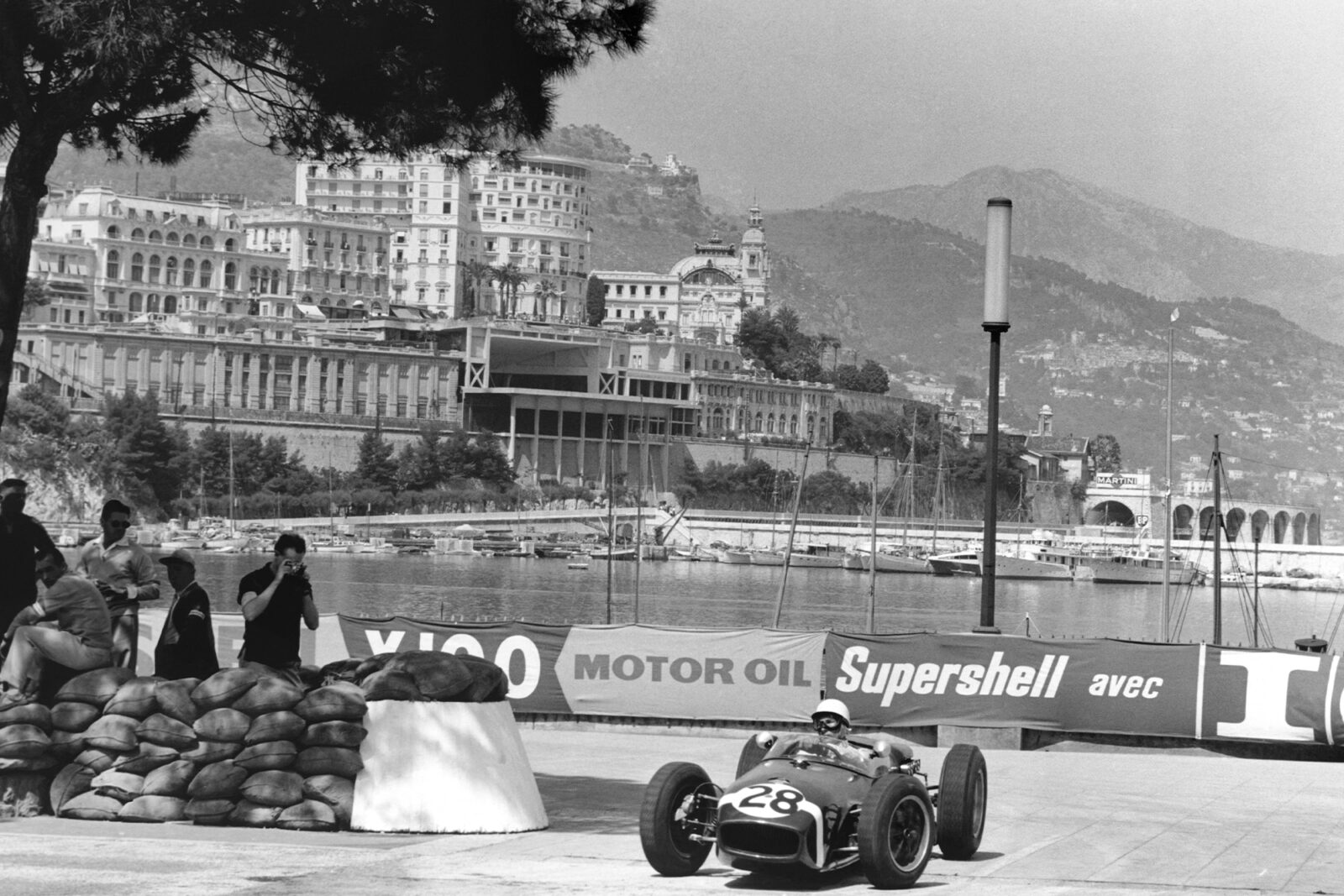
Stirling Moss rounds the gasworks hairpin on his way to victory
Motorsport Images
Being the first major Grand Prix of the European season, everyone was out in full force and the entry list was one of the most interesting seen for some time. The BRM team had three of their 1960 rear-engined cars, with Bonnier, Gurney and Graham Hill as drivers; Cooper had their two 1960 cars in the hands of Brabham and McLaren, these new cars looking much improved, lower and squatter, with five-speed gearboxes and coilspring rear suspension, and they also had one of last year’s cars as a spare.
The other two 1959 works Coopers have been sold, one to CT Atkins, which was now being driven by Salvadori, and the other to Fred Tuck, who entered Halford to drive it. Yeoman Credit had their three Formula One Coopers all immaculately turned out, with Brooks and Bristow as drivers, the third car being kept for practice, and Naylor was there with his homebuilt JBW-Maserati.
The works Lotus team were there with three 1960 rear-engined cars, for Ireland, Stacey and Surtees, and a fourth car, identical to the works cars except for larger-diameter radius rods to the rear wheels and the fact that the car was blue and not green, was being run by the Walker team for Moss to drive.
The Scuderia Eugenio Castellotti, a private Italian concern, entered Scarlatti to drive a new car called a Cooper-Castellotti, which comprised a F1 Cooper chassis fitted with a four-cylinder Ferrari engine of Squalo type, driving through a Collotti five-speed gearbox.
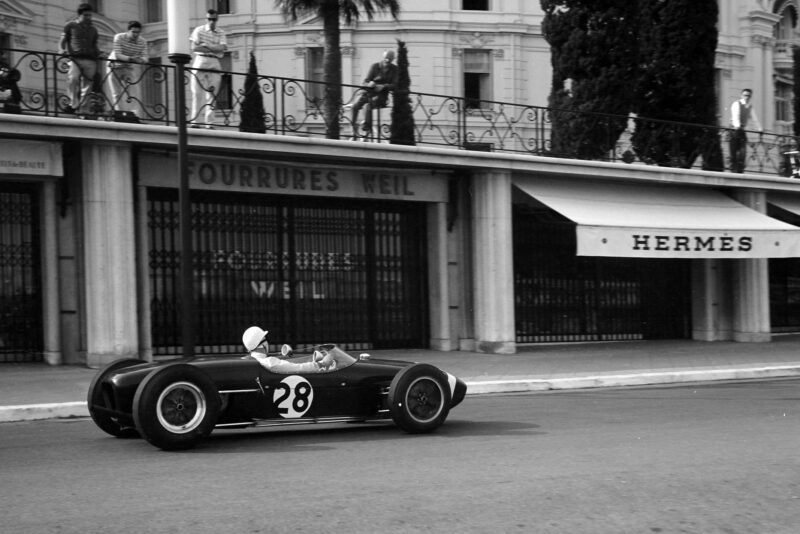
Moss heads into Massenet
Motorsport Images
The Scuderia Ferrari had a full team of Allison, Phil Hill and von Trips with 1960 cars, as raced in Argentina and at Silverstone, having the Dino 246 engine now turned towards the right instead of the left, the whole layout of the gearbox-final drive unit redesigned, the input being on the right of the driving seat instead of the left, and having sidemounted fuel tanks and independent rear suspension by double wishbones and coil springs.
They had a fourth car entered which was brand new and had only been tested the previous Sunday, this being a rear-engined car for Ginther to drive. The front suspension was similar to the Dino 246 cars, though having softer coils-springs, while a Dino 246 V6 engine was mounted behind the driver and coupled directly to a new gearbox-differential unit, with inboard-mounted disc brakes, the rear suspension being independent, as on the other ears, by double-wishbones and coil-springs, though the hub carriers, which also carried the outer wishbone pivots, were now cast alloy instead of welded steel construction.
The Scuderia Centro-Sud entered three Cooper-Maseratis, having four-cylinder Maserati engines coupled to Cooper gearboxes containing Centro-Sud’s own gears and lubrication system, their drivers being Trintignant, Gregory and Burgess, the last named replacing Menditeguy, who could not come from Argentina.
Finally, there were two of the American Scarabs, the F1 cars built and financed by Lance Reventlow and driven by himself and Daigh. These cars, beautifully built and meticulously designed, with a stamp of Indianapolis workmanship about them, had simple rectangular space-frames of small-diameter tubing in which a four-cylinder engine was mounted lying on its side with the crankshaft on the left of the chassis.
Coupled to the engine was a four-speed Chevrolet Corvette gearbox, which drove a propeller-shaft to the rear axle unit mounted on the frame. The driver sits very low, beside the propeller-shaft, with his feet almost touching the rear of the cylinder head. Front suspension is by double-wishbones and coil-springs, as is the rear suspension, the springs at the rear being mounted above the top wishbone and leaning inwards to a frame structure. Cast alloy wheels and Girling disc brakes are used all round, a fuel tank is mounted in the tail and oil carried in a tank on the left of the scuttle.
The four-cylinder engine has desmodromic valve gear similar to that used by Mercedes-Benz six years ago, and Hilborn fuel-injection is used, feeding neat fuel into curved intake pipes attached to the cylinder head, Two magnetos mounted back-to-back and driven from the gear train which drives the camshafts from the front of the crankcase, feed the eight sparking plugs. With a bore and stroke of 95.5 X 86mm a rather low output of 230 bhp quoted.
As can be seen from the foregoing, there was much of interest in the entry list, with three models making their first appearance, the rear-engined Ferrari, the Scarab and the Cooper-Castellotti; the new Coopers, the new Lotus, the IRS Ferrari, and the new BRM all making their first European F1 appearance, and Moss having his first drive in a single-seater Lotus, and a brand new, absolutely standard, rear-engined one at that.
Of the drivers, Gurney, Bristow, Naylor, Stacey, Suttees, Ginther, Burgess, Daigh and Revendow were all making their first acquaintance with the spectacular and exacting Monte Carlo street circuit, with its kerb-stones, tunnel, hairpins and hills. The whole lot added up to having the makings of one of the most interesting Grand Prix meetings for some time. As if this was not enough there was a Formula Junior event as well, containing the best from Britain, Italy, Germany and France.
Qualifying
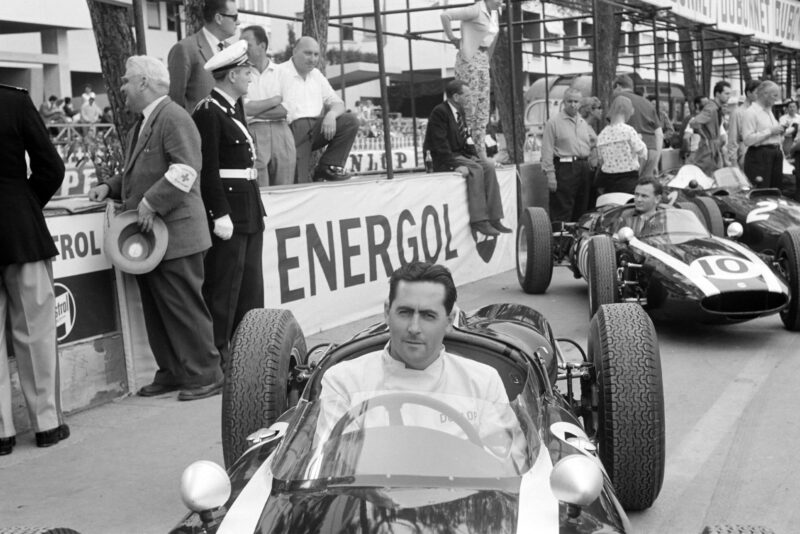
Brabham waits to head out
Motorsport Images
Practice for the Grand Prix was arranged for Thursday afternoon, very early Friday morning, and Saturday afternoon, the race being on the afternoon of Sunday, May 29th. As last year, the number of starters was limited to 16, while 24 entries had been accepted, so that fastest practice laps counted not only for the starting-grid position, as is normal, but also to decide whether you got on the starting grid at all.
In consequence there was some furious activity the moment the circuit was open for practice, and on Thursday afternoon all but the Centro-Sud cars and Scuderia Castellotti car were out, Yeoman Credit having an extra car standing by, as had the Cooper works team. The official lap record for the circuit is in the books as Brabham (Cooper) its 1min 40.4sec during the 1959 race, while during practice that year Moss (Cooper) recorded 1min 39.6sec, so a good time for everyone to aim at this year was 1min 40sec.
“There was some furious activity the moment the circuit was open for practice”
However, bearing in mind that since the last Monaco race the Coventry-Climax engine has had a new cylinder-head design and another 20bhp, as well as an improved torque curve, and that Dunlops have fitted everyone with a new 1960 tyre that has improved lap times by as much as 2sec in 90 sec, and also remembering that Moss was now driving a Lotus as against last year’s Cooper, it was reasonable to suppose that he at least would take 3sec off his best last year. Also there were a lot of other combinations of cars, drivers and technical progress that were well capable of the same thing, such as Bonnier with the rear-engined BRM, Brabham with the 1960 Cooper, and Brooks in a fast Cooper for the first time at Monaco.
Everybody was thrashing round on this first afternoon and watches were clicking and loudspeakers speaking, and everything was all right, until first Salvadori, in one of last year’s works Coopers was credited with a time well under 1min 40sec and then Brooks was given 1min 34.4sec, and things went from bad to worse as Moss was given 1min 32.3sec, and then all was chaos for the official timekeeper’s clock was found to have a progressive error, starting at 3sec and worsening to nearly 6sec as the afternoon wore on.
The result was that the whole practice session was declared null and void, and some approximate times were published, to be regarded purely as a guide, and everyone went home with despairing looks on their faces. Some people had good reason to look happy, in particular Bonnier, whose BRM broke on him almost as soon as he had started; also Stacey, whose Lotus had done likewise, and Ginther, who had not got far in the rear-engined Ferrari due to gear selection being maladjusted; so that none of them had been able to record any times worth considering.
Having closed the track to Formula 1 cars, the place Suddenly became knee-deep in Formula Junior cars of all shapes, sizes and colours, 50 cars having been accepted by the organisers, of which the fastest 22 in practice would be allowed to start in the Junior race. With so many runners the entry was divided into two groups for practice, first the French, German, Swiss and Italian runners, of which Collis Davis with the beautifully made OSCA-Fiat was fastest with 1min 52.9sec, and then the British contingent of Lotus, Cooper, Elva, Gemini, Dolphin, Envoy and Lola, but once again the official timing clock went wrong, this time being 3sec slow, but by hand timing in the various pits the works Lotus, works Lola and the Tyrell-owned Cooper were all below 1min 50sec.
That evening a quiet study was made of a re-introduced magazine, wherein are given complete lap-time charts for all cars in all major Grand Prix races of 1959, and, in particular, study was made of the Monte Carlo GP times. It was most revealing, for Brabham was lapping very consistently in 1min 43sec to 1min 44sec, until on lap 82 he is credited with 1min 48.2sec, and on lap 83 with 1min 46.4sec, the quoted record lap. After that he returned to his consistent 1/43 to 1/44.
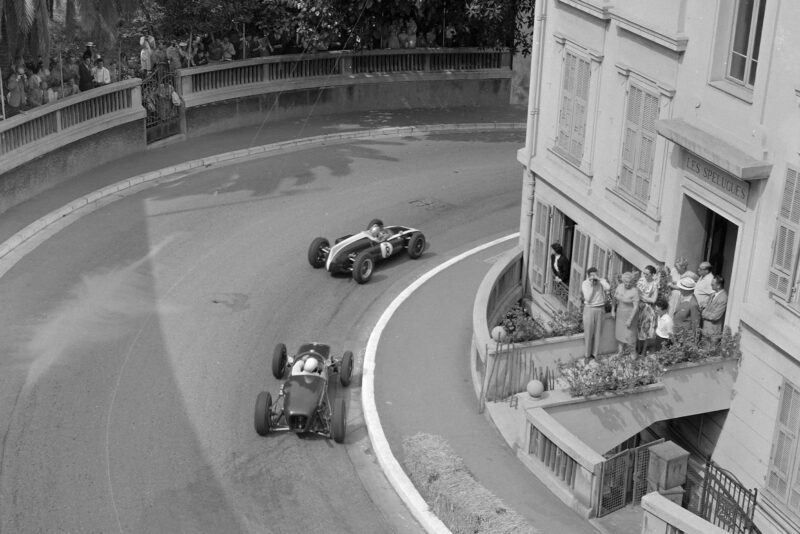
Brabham leads Moss
Motorsport Images
Of course, it could be that Brabham made a mistake on lap 82 which lost him 5sec and tried very hard on lap 83 to make up for it, in fact 3 ec harder than he had ever done before, or it could have been a clerical error in the computing of the marks made by the timing apparatus. Anyway, a difference of 8sec between two consecutive laps at an average speed of 66mph is such that the distance in yards would have been very noticeable.
Apart from this one lap Brabham never looked like getting below 1min 43sec throughout the race, whereas Moss had three laps below this figure, the best being 1min 42.3sec, and Brooks had a 1min 42.5sec. With the first session of this year’s practice being completely confused it was difficult to take any further timings very seriously, so the rest of practice was spent watching cars and drivers and deciding who could drive to a given standard and who couldn’t, and which drivers were artists at the business of fast driving and who were just courageous young men with a lot of skill and bravado.
“Some of the driving was just horrible to watch, while others showed terrific enthusiasm and enjoyment even if they lacked skill”
Very early on Friday morning the gentle old ladies of Monte Carlo, just retired from the gambling tables, and the not-so-gentle young gentlemen who were just returning, had their rest rudely shattered when the miscellaneous foreign contingent of Formula Junior cars rent the silence with a variety of sounds, from the hard and very noisy exhaust of the Dagrada-Lancia, with its special Appia cylinder head with inlet and exhaust on opposite sides, to the screaming ring-ding-ding of the DKW engines in various-chassis.
Some of the driving was just horrible to watch, while others showed terrific enthusiasm and enjoyment even if they lacked skill. Then the British cars took the track once more and some very fast and polished driving was seen, mostly because the handling of the cars was so much better, and the fact that they were running on racing tyres, whereas many of the Continental cars were using quite mundane road tyres, having no fairy godfather in the shape of Mr Dunlop.
When the F1 cars took to the circuit things improved and there was some pretty fast motoring going on, as well as some very wild motoring, and the number of cast alloy wheels that had been ruined by being clouted on kerbs rather indicated that the general run of what passes for a Grand Prix driver today needs to learn something about finesse and fine judgment, and that speed and hard work arc not the only requirements to achieve true success.
Everyone who was out the day before re-appeared, together with three Centro-Sud Cooper-Maseratis, and there was a lot of “keen pressing-on,” even if some of it was “regardless.” There was also some trouble. The rear of the chassis on the Ferrari driven by von Trips broke, Burgess had a big-end bolt break on his Maserati engine which made an awful mess, and Allison crashed badly at the chicane and put himself in hospital. Moss was easily fastest, being a whole second faster than Brabham, who was next, while the works Lotus team were not, being very impressive.
The two Scarabs were being depressingly slow, and just to see if it was the cars or the drivers, Reventlow let Moss try one. He did 1min 45sec, which equalled Jimmy Clark’s best time with the Lotus-Junior, so the answer to the Scarab trouble was cars and drivers. However, there were other factors, such as first time out, first attempt at anything so exacting as Monte Carlo, and the simple fact that their Goodyear tyres are not as good as Dunlop tyres.
A set of Dunlops would certainly have given Moss 1min 43sec. If it had been his own car and fitted him properly he would have done 1min 42sec, and if he had been trying he could have done 1min 41sec, and if starting money had been involved he would have got down to 1min 40sec, which would have been a reasonable time for a new car to new conditions.
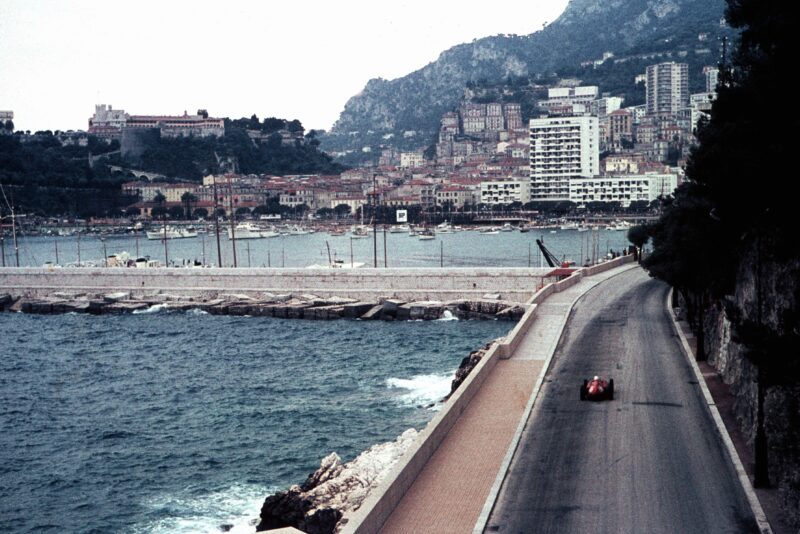
Phil Hill heads past the harbour
On Saturday afternoon the 22 Formula Junior cars weeded out of the huge entry lined up on the grid for a 32-lap race, and Jimmy Clark in the works Lotus was quite uncatchable until the low. tension wire on the ignition came adrift and the stop put him way back. Behind him Henry Taylor in Tyrell’s Cooper-BMG, with a single double-choke Weber carburetter, was battling with Ashdown in the works Lola-Ford, with its two double-choke Weber carburetters, until by hard and forceful driving Taylor got the advantage and took the lead of the race when Clark stopped.
Formula Junior could be really summed up at one point in the race when the first three drivers were Clark, Taylor and Ashdown, all three having been racing in a World Championship Sports-Car race the previous weekend, and none of them owning their cars. So much for Formula Junior being for beginners and amateurs. It was suggested that the Italian gentleman who had thought up Formula Junior had gone away to think up a new Formula!
Below is appended the starting grid for the Junior race, which shows who were the best 22 in practice, while the results of the race speak for themselves.
After this little excitement was over the Grand Prix boys made their final appearance to decide who was going to qualify and who wasn’t, and while some drivers, such as Moss, Brabham, Bonnier, Brooks and Bristow, made no bones about their lap times, being well within their personal limits and sure of a place on the grid, the rest of the runners were scratching hard.
Moss did not improve on his previous best time of 1min 36.3sec, nor did Brabham on his 1min 37.3sec and Brooks and Bristow on their 1min 37.7sec, but Bonnier equalled them on this last day. The Cooper-Castellotti with its old four-cylinder Ferrari engine arrived at last and was driven by Scarlatti and Munaron, while the list of qualifiers was reduced by two as Allison and Burgess were definite non-starters.
Ginther was going very well in the rear-engine Ferrari and looking most happy, Gurney was looking unhappy in the rear-engined BRM, and the Scarabs improved by altering the springs and shock-absorbers and fitting Dunlop tyres. In order to encourage Stacey to go faster Jimmy Clark was allowed a few laps in Ireland’s car and Ireland tried the Walker Lotus to see how it compared with the works cars—it was all right.
Two outstanding efforts among the also-rans were those of Salvadori and Halford, both driving 1959 Coopers among this galaxy of new machinery, for they recorded 1min 38.7sec and 1min39.6sec respectively and were both in the best 16 until right at the end of the afternoon. Ireland and Trintignant finally managed to beat Halford, the Lotus driver, by reason of bad-temper and desperation and the Frenchman by sheer determination. Of those who qualified it was interesting to observe whether they could have kept up their qualifying speed or whether it was one flukey lap. Apart from the accepted masters of Grand Prix driving it was noticeable that Ginther, Gurney and Surtees looked as if they could have gone on all day at their qualifying speeds.
Race
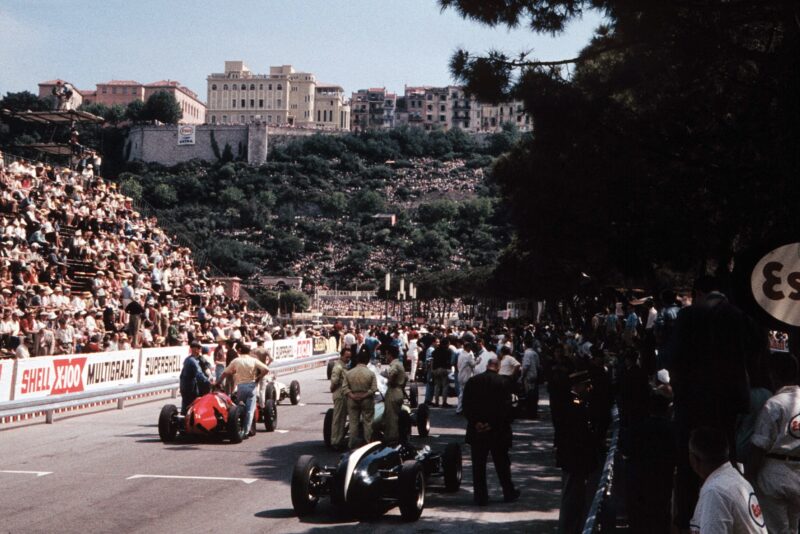
The starting grid
Motorsport Images
On Sunday afternoon the fastest 16 were lined up on the starting grid on the harbour front under a strong sun, but not a cloudless sky, and by Monaco standards the weather prospects were poor. The order was as follows, precedence in the case ties being given to the driver who first recorded the time.
Some idea of the hot pace of practice can he gained from fact that the slowest qualifying time this year was half a second faster than last year’s fastest qualifying time, as recorded by the Official timekeeper’s clock, for what it was worth. At last stopwatches. and times and errors were forgotten and the flag was up, and the serious and straight-forward business of Grand Prix racing was about to start.
“As the flag fell the three cars on the front row spun their rear wheels and snaked viciously and Bonnier shot through from the second row in a superb start”
As the flag fell the three cars on the front row spun their rear wheels and snaked viciously and Bonnier shot through from the second row in a superb start, to lead to the first hairpin, followed by 15 jostling cars, of which Graham Hill’s was roughly elbowed to the inside of the hairpin so that he hardly had room to turn his front wheels. Away they all went to start the first of too laps of the 3.145-kilometre circuit, with Bonnier’s BRM leading the Cooper of Brabham, and Moss in third position.
On the second lap von Trips had to stop out on the circuit to put a small fire out, for the short exhaust pipes under the Ferrari tail had ignited the oily mess on the undertray, and this dropped him from eighth to 14th place, while Trintignant had battled his way up from last on the grid to fifth place. Bonnier was setting the pace, with Brabham at his heels, and on lap four the Australian tried to carve his way in front at the hairpin, but failed, and on lap five Moss took second place.
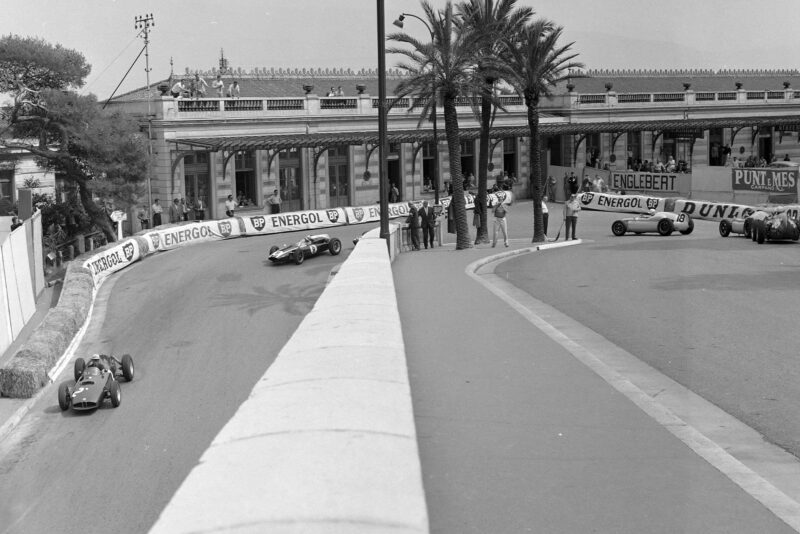
The field rounds Station Hairpin
Motorsport Images
Having closed right up on to Bonnier’s tail Moss was content to sit there and Brabham dropped back, so that Brooks and Phil Hill were catching up with him. Behind them Ireland had dropped back behind Graham Hill and Bristow, and later behind McLaren, so that he was just in front of Surtees. Then came an appreciable gap before Salvadori arrived, keeping just ahead of von Trips and Gurney, with Stacey and Ginther bringing up the rear as Trintignant had gone out on lap five with a broken gearbox.
After 10 laps Bonnier was beginning to wish that Moss would take the lead and waved him by, but Moss stayed behind, indicating, “No, you took the lead, you can set the pace.” However, behind them there was some closing-up taking place for McLaren had caught Bristow and the two of them were urging each other on and catching Phil Hill and Brooks, who in turn had encouraged each other to go faster and had caught Brabham.
By lap 16 the group from third to eighth place were beginning to menace the two leaders, and though Bonnier kept moving over and waving Moss through, the Lotus driver kept waving back, saying, “No you get. on with it.” Bonnier was not too happy as the BRM brake pedal needed pumping before each application of the brakes and he had Moss right on his tail grinning at him.
On lap 17 the danger of the following group was becoming so had that Moss nipped in front of the BRM and in two laps he had pulled out a 5sec lead, while Bonnier was swamped by the others. On lap 18 Bristow had to drop out of this group as his gearbox broke and he retired at the pits, and this left Bonnier, Brabham, Brooks, Phil Hill, Graham Hill and McLaren all nose-to-tail and giving no quarter. Surtees stopped at the pits, unable to select gears properly on his works Lotus, as a bolt head had sheared off the crown-wheel and dropped down into the selector mechanism of the gearbox-final drive unit.
By 25 laps Moss had extended his lead to a comfortable 6sec and was cruising round comfortably, handling the Lotus delicately and not having to try too hard, but behind hint there was a terrible cut-throat battle going on for second place. Bonnier got by Brabham, back into second place, and Brooks was trying to get by the Australian, while the two Hills and McLaren were keeping up the pressure at the end of this group.
Then came a long gap before Ireland arrived, misfiring badly, and an even longer gap before Salvadori, von Trips and Gurney arrived in a tight bunch, with Ginther in the rear-engined Ferrari bringing up the rear as Stacey had retired. His Lotus had broken its engine bearers, the engine had tilted forward, the throttle had jammed on something and stayed partly open, and he clouted a kerb and ruined yet another expensive alloy wheel.
“The row of cars waiting to take second place was so enthralling that no-one noticed that the sun had disappeared and ominous clouds blown up”
The row of cars waiting to take second place was so enthralling that no-one noticed that the sun had disappeared and ominous clouds blown up, until on lap 28 rain began to fall, and this caused things to break up. Brabham got in front of Bonnier, Brooks spun at Ste Devote corner, just before going up the hill to the Casino, and Salvadori spun and stalled at the Gasworks hairpin, and von Trips left Gurney and got ahead of Ireland. Although Salvadori restarted, he stopped at the pits and retired, as the Cooper had been overheating badly.
The whole circuit was now like an icerink with rain on the polished surface, and Moss slowed right down to what he considered a safe pace, but Brabham thought otherwise and closed up, and on lap 34 he took the lead, while Bonnier also caught up to Moss but did not overtake. The rain was falling heavily now and everyone was having to drive with velvet feet in order to get any traction at all, and Phil Hill spun at the Gasworks but kept the engine running, and McLaren and Graham Hill went by, so the order was now Brabham (Cooper), Moss (Lotus), Bonnier (BRM), McLaren (Cooper), Graham Hill (BRM) and Phil Hill (Ferrari); a long way back came von Trips (Ferrari), followed by a deflated Brooks (Cooper), then Ireland (Lotus), Gurney (BRM) and Ginther (Ferrari), and the leader had just caught the last man, which shows how the practice qualifying had sorted out the tail-end Charlies.
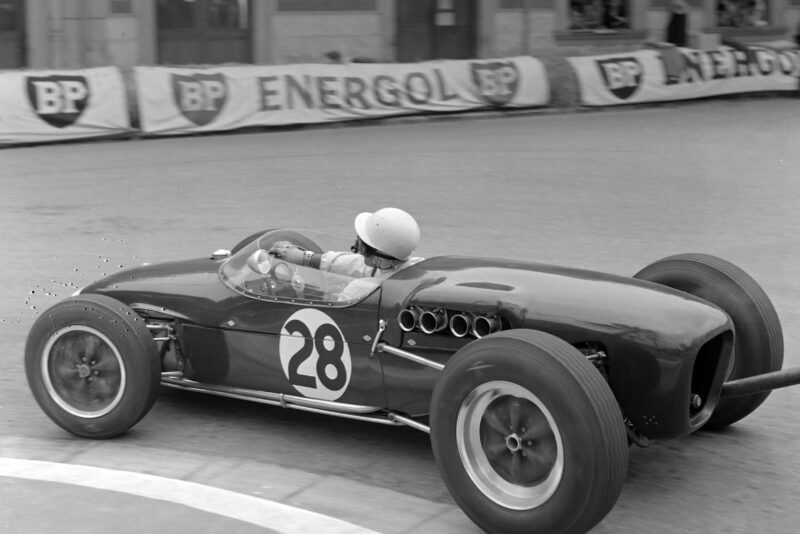
Moss pushes on his way to victory
Motosport Images
On lap 38 the sun re-appeared but the rain was still falling over Monaco and conditions were really dicey, and on lap 41 Brabham found out iust how dicey they were when he lost adhesion at Ste Devote and hit a wall with a real thump and bent the Cooper chassis, so Moss was now back in the lead, treading very wearily on the slippery surface, for just a fraction too much throttle started the rear wheels spinning helplessly. As the rain began to stop Moss drew away from Bonnier, and when it finally stopped on lap 46 the Lotus was 14sec ahead and looking very comfortable once more. Phil Hill was making up for his spin and catching his namesake and McLaren very fast, while Gurney retired at the pits When a rear suspension post and hub carrier split.
By half distance, a very long 50 laps, Moss was still leading Bonnier by 14sec, McLaren by 46sec, and the two Hills by 82sec. Then came von Trips on his own, and Brooks, Ginther and Ireland together a lap behind the leader, and the circuit was drying out fast. There was now no question of anyone challenging Moss and interest centred on Phil Hill, who had caught and passed McLaren and taken third place by reason of some very good wet-road driving, but having got in front he was unable to get away and McLaren and Graham Hill hung on to him.
Ireland’s misfiring engine finally gave out altogether as he went up the hill to the Casino, and he proceeded to start a long push back to the pits. He didn’t know until afterwards that the cause of the misfire and final silence was merely due to the magneto earthing wire chafing through on the rev.-counter drive! On lap 60 the leading Lotus suddenly went on to three cylinders and Moss Stopped at his pit, while Bonnier went by into the lead once more. The trouble with the dark blue Lotus was simply a plug lead having fallen off and Moss was soon back in the race and running as sweetly as ever, and with 40 laps left in which to catch the leading BRM so there was no cause for alarm.
For some laps von Trips had been having trouble changing gear and now his clutch packed up completely, the pedal going down and staying down, so the field was reduced to seven cars. Moss was leisurely catching Bonnier and the Swedish driver was not sure what to do, whether to try and stay ahead or succumb to the inevitable and wait for Moss to catch him up. With 35 laps still to go the Walker pit signalled Moss, but the figure three slipped off the board and he saw 5 laps to go. This woke him up with a start, as he was still 12sec behind, and for two laps he really went motoring, until another pit signal put him at ease again.
On lap 67 he was close behind the BRM, while behind them McLaren had regained third place and drawn away a little from the two Hills, but then as the New Zealander rounded the Gasworks hairpin he opened up too soon and got sideways on. Realising he had used up all his correcting lock, McLaren unwound the steering and stamped on the throttle, and the Cooper pirouetted right round through 360 degrees, but just at that moment the Ferrari of Phil Hill went by on the outside and the BRM of Graham Hill was preparing to go by on the inside. The three cars took off from the hairpin in the order Ferrari, Cooper and BRM, all wagging their tails violently as their wheels spun on the still slippery surface under the trees.
“Graham Hill thought he would accelerate past McLaren but opened up at the wrong moment and spun off the road into the steps of a radio hut, taking his cars nose and radiator completely”
Seeing McLaren still not fully under control, Graham Hill thought he would accelerate past him but opened up at the wrong moment and spun off the road into the steps of a radio hut, taking the nose and radiator completely off the BRM, and stopping very suddenly in a shower of splintered wood. This now left six cars in the race, and before the bits and pieces were cleared up Moss had taken the lead and Ginther stopped at the pits with a grumbling noise coming from the crown-wheel and pinion of the rear-engined Ferrari, so the score was now five cars still running.
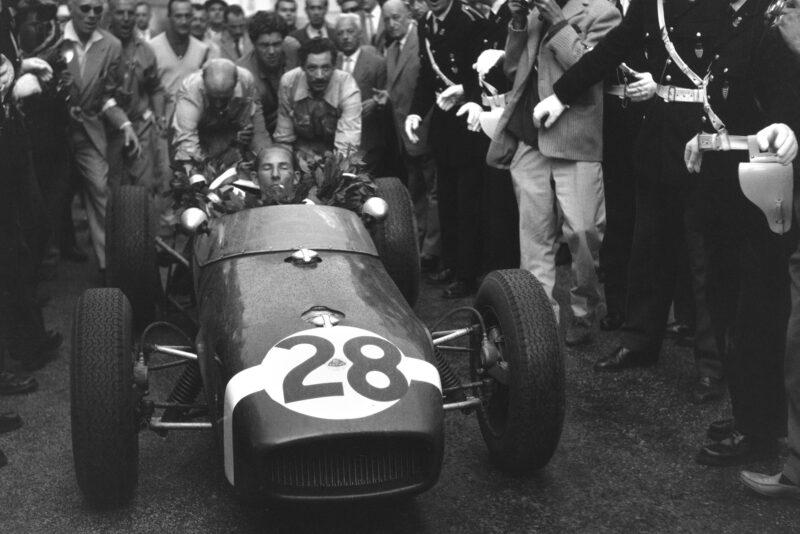
Stirling Moss celebrates victory
Motorsport Images
Providing nothing broke Moss could not fail to win, nor could Bonnier lose second place, but third position was still open, for Phil Hill was third, but only just, and McLaren was beginning to get rough with the red car in his efforts to regain third place. At every opportunity he would thrust his Cooper at the Ferrari until finally Hill was demoralised and let the New Zealander get in front, deciding that things were getting too dicey to be comfortable. However, he did not give up, but pressed bard on McLaren’s waiting for hint to make another mistake. This was still going on on lap 78, when Bonnier stopped at his pit with a split rear suspension upright, just as had happened on Gurney’s car, so that the McLaren vs Hill duel was now for second place, and the only other car left running was Brooks in the crisp-sounding Yeoman Credit Cooper.
Moss reeled off the remaining laps with consistency, handling the Lotus as though it were made of glass, and with to laps still to go a remarkable thing happened. Brabham suddenly appeared at the pits, having restartedkthe bent Cooper, and was obviously going to limp round to finish as there were only four cars left running. Meanwhile a completely exhausted Ireland arrived pushing his Lotus, and other drivers who had retired rushed to their wrecks to do what Brabham was doing. Bonnier set off again slowly and Gurney started another lap with one rear wheel flapping about loosely, while Ginther retrieved the rear-engined Ferrari and pushed it towards the finishing line. This was all very amusing but should not have been allowed by the organisers as the McLaren vs Hill duel was not yet finished and the Ferrari driver might have been going to make a desperate last-lap attempt to get second place and been baulked by one of the slow-moving damaged cars.
An immaculate Moss finished an immaculate drive into first place and McLaren was not challenged by Hill, while Brooks finished an unspectacular fourth. Bonnier, Brabham and Gurney drove over the line, while Ireland and Ginther pushed their cars across. However, neither Brabham nor Gurney had completed 50 laps so their efforts were wasted as they did not qualify as finishers, and the organisers then confused things the way they often do in France, by classifying Graham Hill and von Trips because they had completed more than 50 laps, even though they had both retired out on the circuit. The logical results of the XVIII Monaco GP are as follows :
Further notes on the Grand Prix cars at Monte Carlo
The new rear-engined BRM cars had very unfinished-looking cockpits as the drivers were still sticking bits of sponge rubber here and there to make themselves more comfortable, so there was no point in upholstering the seats. The cars use rack-and-pinion steering from the 1959 cars, which had offset steering columns to bypass the front engines, so they still have offset steering columns even though the engine is no longer in the way, and the result is steering wheels at quite an angle, but this does not seem to worry the drivers.
Fuel is carried in two rubber aircraft-type tanks, one on each side of the cockpit and filled via an inverted Y-shaped pipe from a filler just in front of the windscreen. Exposed internal-toothed rubber belts drive the two magnetos, one on each side of the engine, these magnetos being very small and light as used on the four-cylinder MV racing motorcycle
The new five-speed Cooper gearbox has provision for a reverse gear, and all the selector and locking mechanism is housed in a large bulge on the right-hand side. The gearbox has a I-gallon ribbed sump and this oil is circulated by a pump on the rear of the box, the main shaft being fed internally and each pair of gears also receiving a jet of oil from a cast gallery pipe. With all the gears clear of the sump oil it is in effect a dry-sump system, thereby reducing drag. The rear suspension is by double-wishbones with separate coil-springs surrounding telescopic shock absorbers, while an anti-roll bar runs through a rear frame tube FND is coupled to the wishbones by arms and short links.
The Walker-owned Lotus was identical to the works cars except that the rear radius rods had been increased in diameter as the original plan was to fit the car with a five-speed Collotti gearbox and this would have meant mounting the rear disc brake outboard on the hub carriers, where provision already exists in the original design. However, it was found that the Collotti gearbox was too tall and will have to be canted over a few degrees, and time did not permit of this re-designing, so the Lotus fivespeed gearbox was left in place.
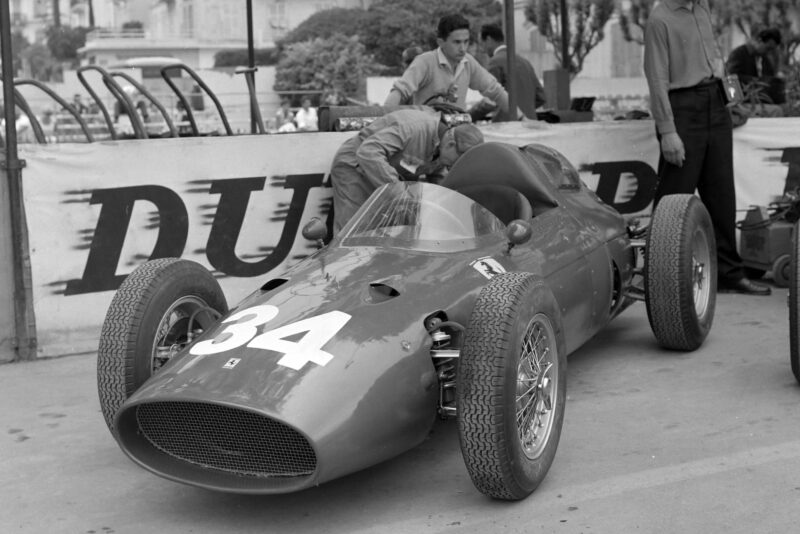
Richie Ginther’s Ferrari 246P
Motorsport Images
The four-cylinder Ferrari engine in the Cooper-Castellotti was such a tight fit that there was no room for the usual horizontal double-choke Weber carburetter, so a pair of double-choke downdraught carburetters were fitted using cast-aluminium right angle manifolds into the inlet ports.
The rear-engine Ferrari had a new gearbox mounted behind the final drive, the shaft from the engine passing right through the box to a clutch mounted in the open air overhanging the end of the gearbox casing; the drive then went back into the gearbox and to the crown-wheel and pinion. Clutch operation is by an exposed hydraulic plunger mounted on the rear cross-member of the frame and pressing into the centre of the clutch in the open air under the tail-cowling of the car. It is significant that the clutch body is fitted with a starter toothed-ring and the gearbox casting has a cradle on the top to take a starter motor, while a bracket on a nearby frame tube held a starter button, indicating that Ferrari are looking to 1961 regulation.
